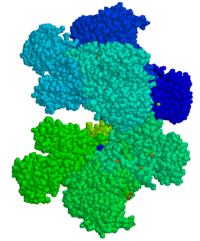
Photo from wikipedia
A 56yearold man of Kurdish/Iraqi descent was diagnosed with Tcell prolymphocytic leukaemia (left, ×100 objective) and planned for treatment with alemtuzumab. He was given rasburicase for prevention of tumour lysis… Click to show full abstract
A 56yearold man of Kurdish/Iraqi descent was diagnosed with Tcell prolymphocytic leukaemia (left, ×100 objective) and planned for treatment with alemtuzumab. He was given rasburicase for prevention of tumour lysis syndrome. Unfortunately, glucose6phosphate dehydrogenase (G6PD) activity was not checked. When his vital signs were repeated a few minutes later, his arterial oxygen saturation by pulse oximetry (SpO2) had inexplicably dropped to 84%, and, notably, did not improve with high flow oxygen. An arterial blood gas was performed. This showed an elevated partial pressure of oxygen (PaO2), and, significantly, methaemoglobin (MetHb) of 14% (normal <1%). A diagnosis of rasburicaseinduced methaemoglobinaemia was made. Given that he was asymptomatic with a modest MetHb percentage, he did not require specific treatment and was monitored for the next few days. However, on day 2 postrasburicase his urine turned dark and he became jaundiced. There was biochemical evidence of haemolysis. His blood film revealed florid changes of oxidative haemolysis, with huge numbers of irregularly contracted cells, blister cells and bite cells (right, ×100 objective). The haemolysis was so severe he required an emergency exchange transfusion and developed haeminduced acute kidney injury. Rasburicase is a recombinant urate oxidase which catalyses the conversion of uric acid to allantoin. Hydrogen peroxide is generated as a byproduct of this reaction. Hydrogen peroxide is a powerful oxidising agent, capable of oxidising the iron ion in haem from the normal 2+ (ferrous) to the 3+ (ferric) state, forming MetHb, which is unable to bind oxygen and is thus functionally useless. MetHb absorbs light at the wavelengths used by pulse oximeters to measure SpO2, which as a result becomes unreliable. Typically, the SpO2 will appear to be 85%– 90%, regardless of the true haemoglobin oxygen saturation, and will not improve with oxygen. This is a useful clue to the diagnosis of methaemoglobinaemia. The hydrogen peroxide generated by rasburicase will also oxidise and denature the haemoglobin molecule itself, resulting in the formation of Heinz bodies and haemolysis in patients whose erythrocytes lack protection from oxidative stress, namely those with G6PD deficiency. This case highlights several important points. Firstly, whenever possible, patients from atrisk groups should be tested for G6PD deficiency prior to rasburicase. Secondly, patients with G6PD deficiency are especially vulnerable to rasburicaseinduced methaemoglobinaemia, which may be the first clue to the underlying diagnosis in those who have not been tested. Thirdly, in such patients, methaemoglobinaemia occurs rapidly whereas haemolysis is delayed by several days. This brief hiatus provides a window of opportunity to check G6PD activity before transfusion and/or reticulocytosis muddies the water. In this case G6PD activity was confirmed to be low at 2.9 iu/gHb.
Journal Title: British Journal of Haematology
Year Published: 2022
Link to full text (if available)
Share on Social Media: Sign Up to like & get
recommendations!